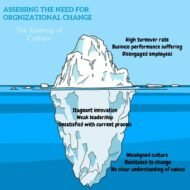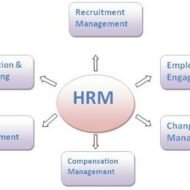Posted by Managementguru in Change management, How To, Human Resource, Learning, Organisational behaviour, Productivity, Strategy, Training & Development
on Jan 19th, 2022 | 0 comments

Today’s leaders around the world cite culture and employee engagement as one of their top organizational challenges. They are in a position to identify and assess the need for change in their organizations as certain issues are only evident like a tip of the iceberg. In order to kick start organizational change management, leaders can do these two things. Constantly Ask Why? Why do we do it this way! If “That’s the way we’ve done it always” is the answer, it’s time to delve deep into underlying issues that are waiting to be addressed.Consult an expert from outside and allow them to experience your firm for a while. They might be able to bring out the existing flaws. New perspectives always end in benefits. Organizational Change Management Factors contributing to failure: Management behavior does not support changeEmployees’ resistant to changeInadequate resources / budgetOther obstacles Organizational culture eats organizational change for breakfast, lunch and dinner- so, don’t leave it unattended. Mind-set Shifts for Organizational Transformation From profit to purposeFrom hierarchies to networksFrom controlling to empoweringFrom planning to experimentationFrom privacy to transparency The transformation journey can’t rely only upon technology innovations as innovations are a result of in-depth factors including mind-set, behavioral constructs, leadership and culture. The most profound business challenge we face today is how to build organizations that can change as fast as change itself. – Gary Hamel An Employee always tend to think and fear “My boss does not like me!” This mentality stops him/her from expressing his/her thoughts freely. This is a definite do-harm factor for the firm as suggestions from employees are valuable as they stem from their work experiences. Be it inter personal or even judgemental, an employee must be given a free hand to sincerely express his point of view. Culture defies strategy The key is to make your employees happy. Happy employees perform better. To make them happy, you just have to do one important thing as a leader. Listen. Listen. Listen. You can be straight forward, treat them like friends in order to create a great atmosphere. By doing this you are extracting their potential with ease. They come forward with excellent suggestions for the good of the company. Employee experience is all about emotional connect. References. Mindset Shifts For Organizational TransformationCulture and...

Posted by Managementguru in Business Management, CSR, Entrepreneurship, Human Resource, Leadership, Strategy
on Dec 4th, 2014 | 0 comments

What it takes to be a Leader What is #Corporate Social Responsibility? High performance is generally measured against key business imperatives including #competitive advantage, #sales, #talent management, #operational efficiency, #return on investment and profitability. It is no longer adequate for a corporation to revel in economic prosperity in isolation from those agents impacted by its actions. Today, a new element of leadership is making an intense difference in weighing business performance: Corporate Social Responsibility. The late 1990s and the early 2000s saw an uptake in businesses giving proceeds or providing volunteers to causes related to their brands. Some called it “corporate social responsibility”; others called it “corporate #philanthropy” or “#corporate citizenship.” Regardless of its title, it was a way for business to increase visibility while raising funds for good. The spotlight is on both increasing the firm’s bottom line and being a good corporate citizen. Keeping abreast of global trends and remaining committed to financial obligations to deliver both private and public benefits have compelled organizations to restructure their frameworks, rules, and business models. Where does the roots of CSR lie? Although the #roots of CSR lie in altruistic activities (such as donations, charity, relief work, etc.) of corporations, globally, the concept of CSR has evolved and now embraces all allied concepts such as triple bottom line, corporate citizenship, philanthropy, #strategic philanthropy, #shared value, #corporate sustainability and business responsibility. You might be wondering what is “Triple bottom line?” (abbreviated as TBL or 3BL) – The term coined by John Elkington in 1994, incorporates the notion of sustainability into business decisions. The TBL is an #accounting framework with three dimensions: social, environmental (or ecological) and financial. “A plethora of research points to a majority of stakeholders agreeing that CSR is a ‘must do’,” and 67% of consumers say they are more likely to buy products and services from a company if they know it supported good causes. Smart Corporations: As a key component in business #strategy and execution, CSR is playing a crucial role in helping organizations to be seen as leaders. Smart corporations are allocating increasing internal resources to CSR investments that include clear objectives and furnish measurable social outcomes. India is a country of multitude contradictions. On the one hand, it has grown to be one of the major economies in the world, and an increasingly important player in the emerging global order, on the other hand, it is still home to the largest number of people living in absolute poverty (even if the proportion of poor people has decreased) and the largest number of malnourished children. This is the sad state of uneven distribution of the benefits of growth which many believe, is the root cause of social unrest. Companies too have been the target of those disconcerted by this lop-sided development and as a result, their contributions to society are under severe scrutiny. Many companies have been astute to sense this development, and have responded proactively while others have done so only when advocated. What it takes to be a Leader-2...

Posted by Managementguru in Business Management, Change management, Decision Making, Entrepreneurship, Human Resource, Leadership, Motivation
on Oct 1st, 2014 | 0 comments

Helpful Tips for Young leaders Here’s a random list of practical advice for young leaders. If you can learn and practice these early in your career, it will help you avoid having to learn them by experience. Delegate, Trust People down the line and Take Advice: While a young business leader may have a flair for leading from the front, one should realize that limited experience is a limiting factor. People are far more likely to take a manager seriously only if he or she listens to and heeds advice. When you act as the sole proprietor of making decisions in your company, people working for you start losing faith in you. It creates what is called “NEGATIVE VIBES” which is not at all good for the overall development of an organization. It is a good practice to communicate and consult with your immediate sub-ordinates before going for big decisions. Learn to let go of control. It is but appropriate to include employees in decision making and you shall be definitely rewarded with more workable strategies. Set an Example: At the same time, one of the most effectual ways to display ability is to lead by example and work hard. A leader must be prepared to shoulder a fair share of the work-load and the #involvement and #commitment he exhibits is undoubtedly infectious and projects him a great team player. The most effective way to earn respect is to lead from the front and help others succeed. Be wary about your conduct, behavior and actions and deeply aware of how it may influence others. Show #conviction: A leader has to have conviction in his/her decisions. If the young manager has done proper ground work and research, then the decision may well be the right one and he/she might be able to stand by and justify the decisions made even when challenged by experienced people. I thoroughly go with this viewpoint “A ‘No‘ uttered from the deepest conviction is better than a ‘Yes‘ merely uttered to please, or worse, to avoid trouble.” Mahatma Gandhi A leader should learn to say ‘NO’ at the right time as indecisiveness is one of history’s greatest leadership killers. Top 25 Leadership Quotes Keep Your Cool in Crisis: Part of being a successful leader is how you handle pressure. In the dynamic business environment you may have to face more challenging and stressful situations and your employees’ judge you based on how you treat such pressure. If you are a man who can see things from the right perspective embracing rationale, your team members will feel reassured by your cool composure, which will in turn develop their trust and confidence in the leader. Manage expectations: Have you ever given a thought about what employees’ expect in you? Communication is a natural gift for leaders and you may very well notice that great leaders are excellent communicators. Here, communication isn’t just talking but a one-on-one, heart-to-heart talk as you would with your close family members. By opening the lines of communication and being accessible, a leader can build a team with people who understand the ##goals and #objectives with ultimate clarity. Present Yourself with Dignity: In Tamil language, there is an age old proverb, “Aal Paadhi Aadai Paadhi”, meaning “#Good Looks Make the Work Easy”. In this modern world, a professional look is mandatory to signify your culture and #personality. A professional, well-dressed businessperson, gives the impression that he thinks that the workplace and the people there are important.” Marilyn Monroe once rightly said “I don’t mind making jokes, but I don’t want to look like...

Posted by Managementguru in Business Management, Change management, Human Resource
on Jun 25th, 2014 | 0 comments

Smith et al. describe management as “Making Organizations perform”. Management is concerned with Individuals who are delegated authority to manage others – Let me call them ‘People with Power’. Activities for achieving goals – ‘Real Action Plans’. A body of knowledge represented by theories and frameworks about people and organizations – ‘Policy Framework’. What do managers do? As we all know they are involved in general management functions like Forecasting Planning Organizing Motivating Co-ordinating Controlling Are you aware of the ‘hidden’ dimensions of a manager’s job? Modern management theories, although highlighting the complexity of the role, have yet to provide sufficient empirical research and advice into key areas that enable both managers and organizations to increase their effectiveness. For example Dealing competently with organizational politics (“You can ignore it, but it won’t go away” – This is how surveyed employees said they viewed office politics) Successfully managing change (Adaptability is about the powerful difference between adapting to cope and adapting to win) Controlling ethical issues and demands (It takes 20 years to build a reputation and five minutes to ruin it. If you think about that, you’ll do things differently.) Developing the role of women managers (Women can be better managers than men because they tend to be more conservative and do their homework. Men tend to take more risk without the research) Ensuring personal ‘survival’ and career success in organizations (A successful man is who lays a firm foundation with the bricks others throw at him.) Safeguarding personal health in a stressful environment (Manage stress before it manages you). How to achieve a more comprehensive view of development? Frameworks for setting, linking, and balancing individual and organizational objectives. Systems for identifying and selecting managers Structures to support, motivate and reward Plans to enable career progression Mechanisms to measure and evaluate performance. HRM and Management Development Human resource management as the name suggests is about the effective management of people in organizations. HRM involves the integration of people with business goals and strategies HRM views people as assets to be developed and utilized in a productive way rather than costs to be minimized or eliminated. The philosophies, ideologies, values and beliefs of management that operate and dominate within the organization have an impact on people management. The practices, policies and management styles that managers employ in their managerial role also align people’s behavior towards organizational goals. Senior managers determine the extent to which people are integrated into the organization’s strategic plans. They set the agenda and create the culture climate of prevailing values, attitudes and behavior. Middle and junior managers translate and ‘operationalize’ broader human resource strategies and policies. They give HRM its meaning and reality. It is their perfect management style and actual behavior that decided how the human resources is deployed and managed and thus what people experience as human resource management. The way managers themselves are managed and developed is a significant influencing factor in the way people are subsequently...








